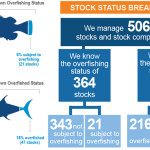The U.S. food and beverage industry experienced 23.1 percent more recalls in Q1 2023 over the previous quarter, according to Sedgwick, a provider of technology-enabled risk, benefits, and integrated business solutions.
Undeclared allergens, and particularly nuts and sesame – which was added as a major food allergen in January 2023 – were the leading cause of U.S. food recalls for the ninth consecutive quarter, with 56 recalls in Q1 2023. Foreign material, bacterial contamination, misbranding, and packaging defects were the other leading reasons for recalls.
The U.S. Food and Drug Administration and the U.S. Department of Agriculture regulate separate seafood products sold in the United States, and both issued recalls on seafood products in the quarter. Food product recalls are at a 10-year high, and given the increased frequency of severe weather events and the anticipated increase of pathogens in these altered ecosystems, a changing climate is expected to have a significant impact on food safety, according to Sedgwick Senior Vice President of Brand Protection Chris Harvey.
In addition, new traceability rules from the U.S. Food and Drug Administration (FDA), alongside a USD 41 million (EUR 38.4 million) increase to the FDA budget, suggest audits and recall events will continue to rise in the future, Harvey said.
"As the number of recall events increase across industries, the risks to manufacturers grow more serious, with increased regulatory enforcement and a more publicized recall process," Harvey said. "Regulators are working to prioritize product safety while balancing innovation with oversight – meaning manufacturers can expect to contend with new rules and regulations. Businesses will need to remain agile to keep pace with these changes and prepare for future ones."
In February 2023, the FDA issued a report, "Activities for the Safety of Imported Seafood," outlining how it is using its mandate under the Food Safety Modernization Act and the FDA Strategy for the Safety of Imported Food to ensure imported seafood is safe for Americans to eat. In the guidance, the FDA outlined an ambitious list of topics it will tackle in 2023 with draft or final guidance, including allergens, food additives, topics related to the Food Safety Modernization Act (FSMA), and labeling, according to Harvey. The FDA Food Traceability Final Rule, approved in 2011 and published in 2022, takes effect January 2026. Primarily, the rule was developed to enhance the FDA’s ability to quickly and accurately trace the source of contaminated product in the event of an outbreak.
Under the rule, the seafood industry will face …
Photo courtesy of United States Seafoods








